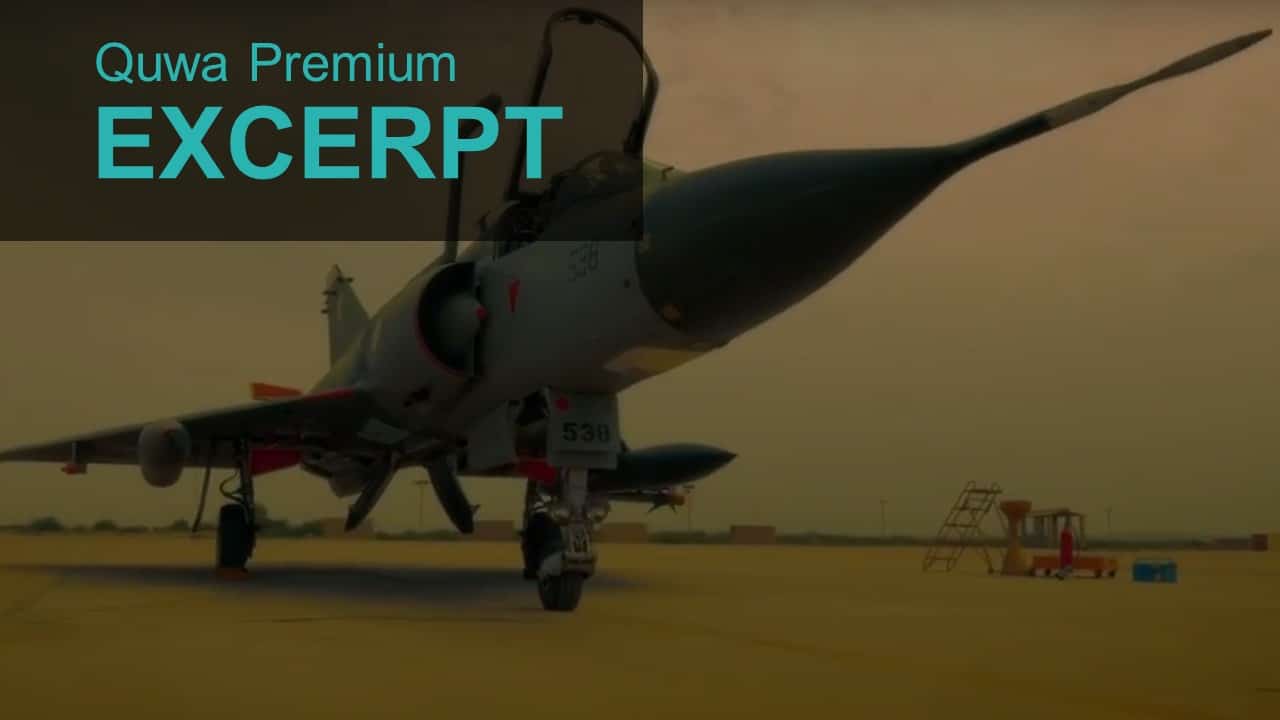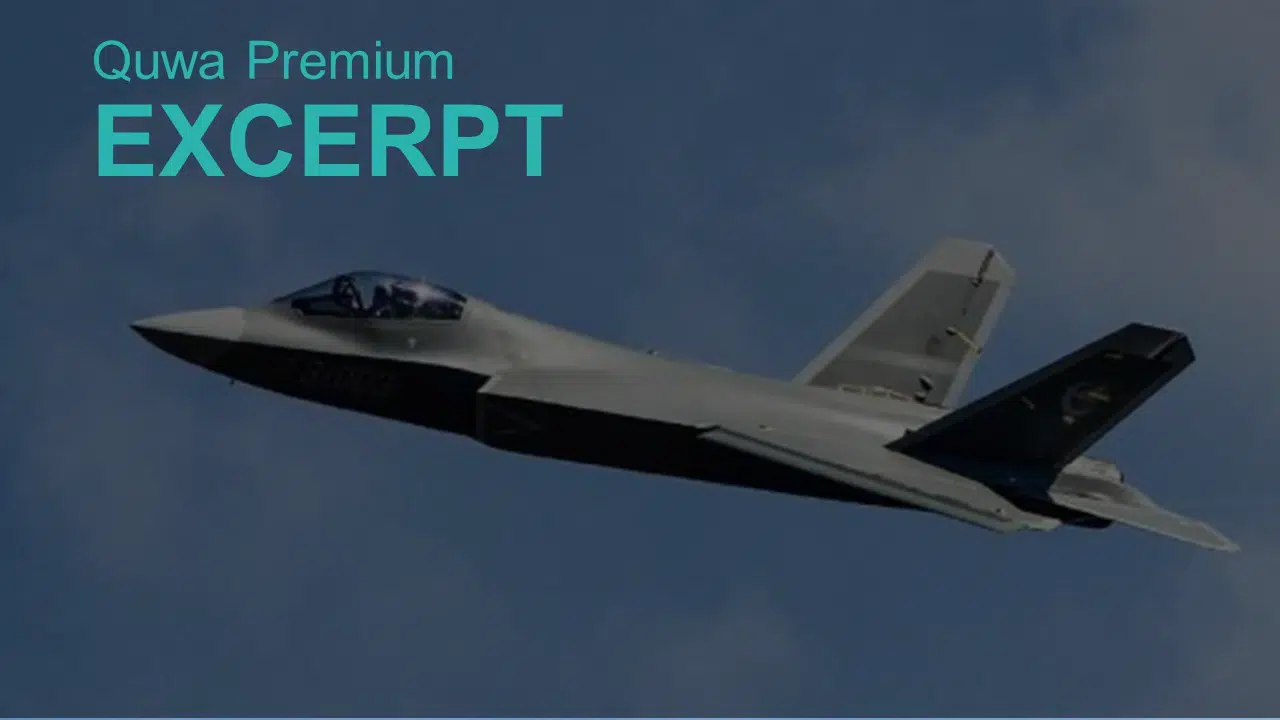1930Views

Pakistan’s Mirages: Today’s Success and Tomorrow’s Roadmap
Note: This article is a partial re-write of an older Quwa Premium piece – “Pakistan’s Mirages: Specialists Enduring Out of Necessity.” However, the latter half of this article delves into how the PAF used the Mirage III/5 during Swift Retort as well as how the PAF may configure the JF-17 to support the Mirages and how the lessons of using the Mirages in strike and maritime operations for decades could confirm Project AZM.
In April 2018, the AFP News Agency published an article detailing its visit to the Mirage Rebuild Factory (MRF) at Pakistan Aeronautical Complex (PAC).[1] The complete AFP article is available on Dawn News, but it provides an insight into the MRF’s activities in keeping the Pakistan Air Force’s (PAF) Dassault Mirage III and 5 fighters serviceable, especially with much of the fleet averaging 50 years in terms of airframe age.[2]
Interestingly, AFP was able to extract the reason why the PAF persists with operating the Mirage III/5, i.e. its continuing value as an effective strike aircraft, which the PAF Air Commodore Tariq Yazdani described as a “very agile aircraft capable of penetrating deep into the enemy’s territory without being detected by radar, which makes its sole mission — to drop bombs on the enemy’s position — quite easy.”[3]
Since its introduction to the PAF fleet in the 1968, the Mirage III/5 has transitioned from being the PAF’s mainstay high-tech fighter in the 1970s to a complementary asset to the newer F-16 in the 1980s. Today, the Mirage III/5 may not command as much attention as the F-16 and JF-17 as an air-to-air asset, but it is significantly more than just a valuable strike fighter – it is the PAF’s prime strike asset.
This prominence stems from two factors.
First is the straightforward reality that the PAF has not yet been able to secure a suitable successor. The cause primarily stems from a lack of funding (i.e., cash on-hand or financing mechanisms such as a supplier line-of-credit), but also a limited pool of willing suppliers with aircraft that can substantively improve upon the Mirage III/5 to warrant the costly shift to a new platform.
Second, the Mirage III/5 is the PAF’s sole delivery platform for key stand-off weapons (SOW), namely the H-2 and H-4 glide-bombs (which are derived from the Denel Dynamics Raptor I and Raptor II – ranges of 60 km and 120 km, respectively) and Ra’ad I and Ra’ad II air-launched cruise missiles (ALCM), which have ranges of 350 km and 600 km, respectively. The Mirage 5PA3 can also carry the MBDA AM39 Exocet anti-ship missile (AShM). Prior to the C-802-equipped JF-17, the Mirage 5PA3 was the PAF’s only anti-ship warfare (AShW) asset. It still operates from Masroor Air Base under the No. 32 Tactical Wing.
The Mirage Rebuild Factory
The PAF established the MRF in 1978. In the subsequent 40 years, the MRF has serviced (as of November 2017) a total of 350 aircraft and 2,280 engines.[4] The PAF has invested considerably in the MRF, essentially building a robust infrastructure base to stretch airframe lives beyond the lifespan intended by Dassault.
However, the extent to which MRF is undertaking depot-level maintenance, repair and overhaul (MRO) work today is the culmination of four decades of gradual capacity growth at PAC. When it began its MRO work, PAC relied on imported parts – originally from the original equipment manufacturer (OEM) and then from surplus Mirage III/5 aircraft from Australia, France, Libya and other places – to ensure and/or extend airframe lives.[5] PAC reduced this reliance (albeit, not entirely) by undertaking some manufacturing work, particularly of wing components and parts for the Atar-09C turbojet engine.[6]
It appears that since the 1980s, PAC accumulated a series of turnkey repair facilities from Dassault – i.e. Wing Refurbishing Facility, Fuselage Structural Repair and Engine Overhaul Wing.[7] Granted, the Mirages are old platforms, but compared to other aging platforms – such as the C-130B/E, AH-1F/S and in time the F-16A/Bs – PAC is essentially the best place to replenish certain aerostructures (such as the wings’ ribs).[8]
Moreover, new investments – such as a structural health management system from Critical Materials in Portugal – will enhance MRF’s ability to assess the integrity of the Mirage III/5’s aerostructures so that it can optimize its resources while maintaining or even improving the overall maintenance process.[9]
Operational Deployment & Future
It is important to note that the Mirage III/5 itself was designed as a comparatively lightweight fighter. It is not a ‘deep-strike fighter’ in terms of the range and payload flexibility a Flanker-series or even a medium-weight platform such as the Mirage 2000, F-16 or J-10 would offer. However, through the integration of SOWs, air-to-air refueling (AAR), and shrewd deployment strategies, the PAF’s Mirages are strike assets.
In terms of exploiting geostrategic realities, Pakistan’s immediate proximity to India means that the PAF’s Mirage III/5s can deploy SOWs without needing fuel-tanks to sustain a long-range flight (there is no need for it). The presence of forward operating bases, civilian airstrips and makeshift runways using highways enable the PAF to deploy and recover its aircraft with relative ease. Thus, the inherent limitation in combat radius is not an issue for the PAF in terms of airstrikes on nearby targets, albeit targets within the coverage provided by the PAF’s SOW arsenal, especially the H-2 and H-4 (local versions of the Denel Raptor-I/II).
The PAF had shown a limited measure of this capability in its response to India’s attempted air strikes over Balakot in 2019, i.e., Swift Retort. The PAF’s strike package at the time consisted of two Mirage 5PAs and two dual-seat Mirage IIIDAs. The PAF armed the Mirage 5PAs with H-4s, i.e., a gliding SOW with a rocket-assist motor capable of reaching a range of 120 km. Once the Mirage 5PAs launched their H-4 ordnances, operators sitting in the rear seat of each Mirage IIIDA manually operated the H-4s to their targets using a data-link-based communications protocol and the H-4’s TV-seeker. The PAF says it opted to intentionally miss the military targets on the other side of the Line-of-Control (so as to limit escalation).[10]
End of Excerpt (1,004/2,205 words)
You can read the complete article by logging in (click here) or subscribing to Quwa Premium (click here).
Need More Info on the Pakistan Air Force? See Below for the Latest News and Insights:
- Pakistan to Use Dual-Seat JF-17Bs for Training and Frontline Use
- Pakistan Offers Glimpses of Next-Generation Fighter Program
- Pakistan Should Prioritize Investment in the JF-17
- Pakistan Selects KLJ-7A AESA Radar for JF-17 Block-III
- Will Pakistan Procure an Off-the-Shelf Fighter?
[1] “Thrifty at 50: How the Pakistan Air Force keeps ageing Mirages flying”. AFP (via Dawn News). 29 April 2018. URL: https://www.dawn.com/news/1404605 (Last Accessed: 04 May 2018).
[2] Ibid.
[3] Ibid.
[4] Alan Warnes. “Masters of Mirage maintenance”. Air Forces Monthly. November 2017.
[5] Ibid.
[6] Ibid.
[7] Ibid.
[8] Ibid.
[9] Press Release. “Critical Materials Selected by Pakistan Aeronautical Complex to Deliver Advanced DTA/SHM Technologies”. Critical Materials. 22 June 2017. URL: http://www.critical-materials.com/en/media/short-news/posts/short-news-1/critical-materials-selected-by-pakistan-aeronautical-complex#.Wu-3B4gvyUl (Last Accessed: 04 May 2018).
[10] Alan Warnes. “Operation Swift Retort: One Year On” Key Military. 19 March 2020. URL: https://www.keymilitary.com/article/operation-swift-retort-one-year


